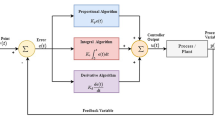Abstract
Many tuning methods for controlling stable processes with dead time can be found in the literature. Usually, proportional-integral-derivative (PID) controllers are used for this purpose. In practice, stable processes with inverse response characteristics can also be encountered. Addition of inverse response characteristic makes the control of a process more troublesome. Therefore, the use of PID controllers for tuning inverse response processes may lead to unsatisfactory closed loop responses. On the other hand, PI-PD controllers have been shown to perform in very good closed loop responses where PID controllers cannot result in satisfactory closed loop responses. Therefore, this paper adopts the structure previously suggested by the author for controlling processes without inverse response. This adaptation, in conjunction with a simple but powerful factorization, eliminates the affect of the inverse response term in the closed loop transfer function, hence resulting in a simplified design procedure. Tuning parameters of the PI-PD controller used in the control structure are found using standard forms, which is a simple algebraic approach and proven to be resulting in very satisfactory closed loop responses. Simulation examples are provided to illustrate the superiority of the proposed method over some existing ones.

















Similar content being viewed by others
References
Kaya I, Tan N, Atherton DP (2006) A refinement procedure for PID controllers. Electr Eng 88:215–221
Atherton DP, Boz AF (1998) Using standard forms for controller design. In: Proceedings of UKACC Control’98, pp. 1066-1071
Kaya I (2003) A PI-PD controller design for control of unstable and integrating processes. ISA Trans 42:111–121
Kaya I (2003) A new smith predictor and controller for control of processes with long dead time. ISA Trans 42:101–110
Kaya I, Tan N, Atherton DP (2007) Improved cascade control structure for enhanced performance. J Process Control 17:3–16
Kaya I, Atherton DP (2008) Use of Smith predictor in the outer loop for cascaded control of unstable and integrating processes. Ind Eng Chem Res 47:1981–1987
Shamsuzzoha M, Skogestad S (2010) The setpoint overshoot method: a simple and fast closed-loop approach for PID tuning. J Process Control 20:1220–1234
Matausek MR, Sekara TB (2011) PID controller frequency-domain tuning for stable, integrating and unstable processes, including dead-time. J Process Control 2:17–27
Shamsuzzoha M (2013) Closed-loop PI/PID controller tuning for stable and integrating process with time delay. Ind Eng Chem Res 52:12973–12992
Li K (2013) PID tuning for optimal closed-loop performance with specified gain and phase margins. IEEE Trans Control Syst Technol 21:1024–1030
Lee J, Cho W, Edgar TF (2014) Simple analytic PID controller tuning rules revisited. Ind Eng Chem Res 53:5038–5047
Pavkovic D, Polak S, Zorc D (2014) PID controller auto-tuning based on process step response and damping optimum criterion. ISA Trans 53:85–96
Cho W, Lee J, Edgar TF (2014) Simple analytic proportional-integral-derivative (PID) controller tuning rules for unstable processes. Ind Eng Chem Res 53:5048–5054
Ali A, Majhi S (2011) Integral criteria for optimal tuning of PI/PID controllers for integrating processes. Asaian J Control 13:328–337
Ogunnaike BA, Ray WH (1994) Process dynamics, modelling and control. Oxford University Press, Oxford
Stephanopoulos G (1984) Chemical process control: an introduction to theory and practice. Prentice-Hall, Englewood Cliffs
Waller KVT, Nygardas CG (1975) On inverse response in process control. Ind Eng Chem Fundam 14:221–223
Luyben WL (2000) Tuning Proportional-Integral controllers for processes with both inverse response and dead time. Ind Eng Chem Res 39:973–976
Chien IL, Chung YC, Chen BS, Chuang CY (2003) Simple PID controller tuning method for processes with inverse response plus dead time or large overshoot response plus dead time. Ind Eng Chem Res 42:4461–4477
Camacho O, Rojas R, Garcia W (1999) Variable structure control applied to chemical processes with inverse response. ISA Trans 38:55–72
Balaguer P, Alfaro V, Arrieta O (2011) Second order inverse response process identification from transient step response. ISA Trans 50:231–238
Jeng JC, Lin SW (2012) Robust proportional-integral-derivative controller design for stable/integrating processes with inverse response and time delay. Ind Eng Chem Res 51:2652–2665
Smith OJ (1959) A controller to overcome dead time. ISA J 6:28–33
Barlett AC, Hollot CV, Lin H (1988) Root locations of an entire polytope of polynomials: it suffices to check the edge. Math Control Signal Syst 1:61–71
Bhattacharyya SP, Chapellat H, Keel LH (1995) Robust control: the parametric approach. Prentice Hall
Tan N (2002) Computation of the frequency response of multilinear affine systems. IEEE Trans Autom Control 47:1691–1696
Skogestad S (2003) Simple analytic rules for model reduction and PID controller tuning. J Process Control 13:291–309
Author information
Authors and Affiliations
Corresponding author
Rights and permissions
About this article
Cite this article
Kaya, I. PI-PD controllers for controlling stable processes with inverse response and dead time. Electr Eng 98, 55–65 (2016). https://doi.org/10.1007/s00202-015-0352-3
Received:
Accepted:
Published:
Issue Date:
DOI: https://doi.org/10.1007/s00202-015-0352-3




